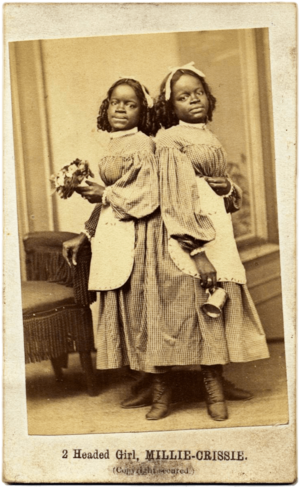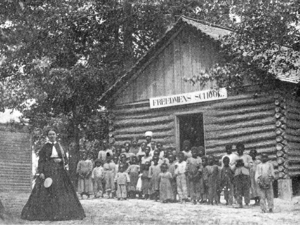Disability in American slavery facts for kids
About 9 out of every 100 enslaved people in America had a disability before the Emancipation Proclamation. This meant hundreds of thousands of people had conditions that affected their bodies, senses, minds, or development. Before the American Civil War, a person was called "disabled" if their injury or condition stopped them from doing hard work. This included things like blindness, deafness, losing a limb, or even not being able to have children.
Since disabled enslaved people often couldn't do the usual farm work, they often relied on their owners and mothers for help. They usually worked indoors, like in kitchens or helping with children. After slavery ended, many disabled former slaves stayed on plantations. Later, the government started setting up hospitals and special homes for them.
Contents
What "Disabled" Meant for Enslaved People
Before the Civil War, the word "disabled" didn't just mean someone born with a physical or mental condition. Slave owners also used it for enslaved people who became sick or injured due to harsh conditions. This included not enough food, severe punishments, dangerous work, or abuse.
Owners had an idea called "soundness." An enslaved person was considered "sound" if they could do manual labor, were valuable to sell, and were healthy. Because of this, many enslaved African Americans were called disabled due to injuries that stopped them from working.
These "injuries" included diseases like rickets (weak bones), pellagra (skin and digestion problems), and scurvy (vitamin C lack). These diseases could cause poor eyesight or stop growth. Injuries like broken bones, burns, lost limbs, or head injuries also made enslaved people unable to work.
One common disability was blindness. This could be from birth defects, long days working in the fields, or severe beatings that harmed the eyes. For women, not being able to have children was also seen as a disability. This was because having children was considered a very important duty. Other issues like mental health problems, conditions like epilepsy, old age, and injuries from abuse also led to enslaved people being called disabled.
Daily Life and Work
When enslaved children were born with disabilities, it was a challenge for both their owners and their mothers. Doctors and mothers spent more time caring for these children. Sometimes, children were sent to doctors for surgeries to try and "fix" their disabilities. Owners hoped this would make them able to work.
Many disabled children had surgeries to try and correct conditions like "clubbed feet" or blindness. If owners didn't pay for medical care, the mothers became the main caregivers. Besides caring for a disabled child, mothers also had to care for their other children. They also dealt with their own health problems from age and living conditions, all while doing their plantation work. Mothers often put their disabled child's needs first, which could lead to punishment.
Despite the difficulties of raising a disabled child on a plantation, mothers had less fear of their disabled child being sold away. Sometimes, slave-owning families would even buy disabled children along with their enslaved mothers out of pity.
Enslaved people with disabilities often did similar work and faced similar punishments as others. Their tasks usually included cooking, sewing, gardening, and caring for children or animals. Even though their jobs were often limited, they were not always easy. For example, enslaved people who cooked had to wake up before everyone else. They had to grind meat and gather wood for fires, which was hard work.
Those who worked in nurseries cared for young children all day. This was often too much for older, disabled enslaved people. Sometimes, disabled enslaved people were given very unusual tasks. For example, a blind enslaved person might drive a cart to deliver food to others in the fields. Some owners sold disabled enslaved people to become tradesmen, like tailors or shoemakers. Many enslaved people thought these jobs were safer than working on a plantation.
How They Were Treated
Enslaved African Americans with disabilities often faced harsh punishments because they couldn't do tasks as quickly or easily. Their physical or mental limits made it hard to keep up with the heavy workloads, especially in the fields. They were sometimes whipped.
More often, enslaved people with disabilities were simply neglected. Owners dealt with older disabled enslaved people in different ways. They might give them less food. Sometimes, owners would just sell them. When disabled enslaved people became "too old," owners might force them to move to cabins in the woods and make them fend for themselves.
Slave owners sometimes sold enslaved people with disabilities to doctors for medical research. Doctors tried new treatments and surgeries on these enslaved people. The hope was that doctors could "fix" their disabilities. This research was also meant to help white people with similar conditions.
Enslaved people with disabilities were also used for surgical demonstrations. For example, a doctor named Crawford Long discovered that sulfuric ether could be used to prevent pain during surgery. He found this out by performing surgeries, including finger and toe amputations, on disabled African American enslaved people. Like other doctors, Long believed his findings could help white people with similar health problems. White doctors also studied African American enslaved people born with birth defects.
An example of disabled enslaved people who faced harsh treatment were Millie and Christine McKoy. They were twins born joined at the hip. Before they were two years old, they were sold to a man who showed them in carnivals and other events. Doctors also examined them. Throughout their lives, the McKoy twins were shown across the United States and Europe. They were also kidnapped multiple times and mistreated by medical professionals.
After the Civil War
During the American Civil War, many enslaved African Americans heard about the Union Army advancing. They left their plantations to join the Union Army. However, the Union Army mostly wanted strong, healthy enslaved people who could dig ditches, wash uniforms, and cook. Because of this, disabled enslaved people who couldn't escape were forced to stay enslaved.
Even after the Civil War ended, disabled former slaves who couldn't find work often had to stay on their plantations. They continued to work for their former owners. The government decided to help people with disabilities. Secretary of War Edwin Stanton said that society has a duty to help those who are poor, disabled, or unable to care for themselves.
In March 1865, the U.S. government created the Freedmen's Bureau. This group helped newly freed African Americans, including those with disabilities, adjust to freedom. The Freedmen's Bureau helped in two main ways. First, they counted the number of disabled people in the South to figure out how much help was needed. Second, they set up special homes and hospitals for disabled former slaves.
However, these places often didn't have enough money. So, the Bureau sometimes made the disabled African Americans work to help pay for things. For example, they worked in vegetable gardens, cleaned laundry, and even helped build facilities.
See also
- Disability in the United States



